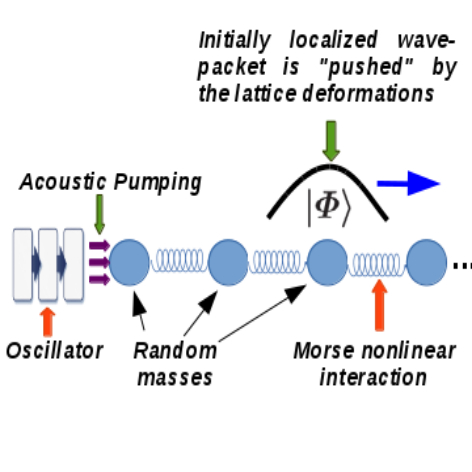
High education

Research

Publications

Student's Works

My Students

Links

Hobby

|
|
Eletronic eigenstates in low dimensional disordered systems (Selected Papers: PRL1,PRL2,EPL,JPCM1,JPCM2)
Eletronic transport in nonlinear media (Selected Papers: PRE, CNSNS, JPCM,PRL,JPCM)
Transport of interacting electrons in low dimensional systems (Selected Papers: PRB1,PRB2)
Transport in apperiodic low dimensional systems (Selected Papers: PRB1,)
Spin waves in nonperiodic ferromagnetic systems (Selected Papers:jmmm2,PLA, PRB1,EPJB,jmmm1)
Electronic transport in DNA(Selected Papers: JPCM, PR,PRE,Phys. A,JPCM)
Statistical mechanics(Selected Papers: PRE,PRB1,PRB2)
Elastic wave localization(Selected Papers: EPJB2,EPJB1,JPCM,JPCM2)
Numerical methods in condensed matter physics (Selected Papers: EPJB,IJMPC)
Summary of main results
|
In this work we have investigated the dynamics of a single electron in a nonlinear chain
subjected to disorder and in the presence of an external acoustic wave.
We have used a quantum mechanics formalism to describe the electron transport and a classical nonlinear Hamiltonian for the lattice vibrations.
We emphasize that our model contains two distinct sources of disorder: disorder within the on-site energies and at the mass distribution. Therefore, both dynamics quantum and classical equations contains disordered terms.
The electron-lattice interaction was incorporated into the model
through a hopping term defined as an exponential function of the effective distance between the nearest neighbors masses.
By initializing the system with a fully localized wave packet at the left end of the chain
and placing a Gaussian acoustic pulse generator at the same side, we observed that the acoustic wave associated with the electron-lattice interaction is able to sustain the wave packets dynamics even at the presence of intrinsic disorder (figure below by M.O.Sales). paper.

|
|
We consider interacting electrons moving in a nonlinear Morse lattice.
We set the initial conditions as follows: electrons were initially localized at
the center of the chain and a solitonic deformation was produced by an impulse
excitation on the center of chain. By solving quantum and classical equations
for this system numerically, we found that a fraction of electronic wave-function was trapped by the solitonic
excitation and trapping specificities depend on the degree of interaction among
electrons. Also, there is evidence that the effective electron velocity depends
on Coulomb interaction and electron-phonon coupling in a nontrivial
way. This association is explained in detail along this work.
In addition, we briefly discuss the dependence of our results with the type of
initial condition we choose for the electrons and lattice.To see more read the paper.
|
|
Considering non-interacting electrons in a one-dimension alloy in
which atoms are coupled by a Morse potential, we study the system dynamics in the
presence of a static electric field. Calculations are performed assuming a quantum mechanics treatment for the
electronic transport and a classical Hamiltonian model for the lattice vibrations. Next, we report numerical evidence of
the existence of a soliton-electron pair even when the electric field is turned on and we offer a
description of how the existence of such phase depends on the magnitude of the electric field and the electron-phonon interaction.
To see more read the paper.
|
|
We consider a simple 1d one-electron model
containing the static randomness arising from the alloy composition
and the coupling between electron and atomic vibration. The electron-vibration coupling used can be understood
intuitively. The transfer integral between neighbouring atoms-also called the hopping term-represents
the electron's kinetic energy and depends on the effective distance between neighbouring atoms.
Basically, the hopping term increases when the distance between neighbouring atoms decreases.
By using this formalism we have found a breakdown of Anderson localization. Our main result
indicates that the coupling between atomic vibration and the electron's kinetic energy can
promote a long-time subdiffusive regime. The numerical experiments were done by directly measuring the mean
width of the electron wave function. To see more read the paper or the
labtalk written to journal.
|
|
The absence of electronic self-trapping in one-dimensional lattices with nonadiabatic electron-phonon interaction. In ref. PRL we show that a delayed thirdorder
nonlinearity destroy the usual delocalized-self-trapped transition present in nonlinear chains. We found that for the case of long
delay times, self-trapping takes place only for much
stronger nonlinearities. As a consequence, the electronic
transport retains its metallic character in slowly responding
media for a wide range of nonlinear strengths.
|
|
The effect of the on-site Hubbard
interaction U on the dynamics of two electrons subjected to an external electric field and restricted to move in a
linear chain with open boundaries. For electrons initially far apart, the wave-packet develops Bloch oscillations
whose characteristic frequency is in agreement with a semi-classical calculation. For initially close electrons in a singlet state, a frequency doubling
sets up, which is more pronounced for intermediate couplings. We discuss this effect by revealing the opposite trends the electron-electron
coupling produces on the wave-packet components corresponding to bounded and unbounded states.
|
|
The existence of Bloch oscilations
in low-dimensional systems with long-range correlated diagonal disorder. In ref. PRL2 we show
that this type of correlated disorder does not destroy the coherence of Bloch oscilations.
|
|
The existence of extended states in low-dimensional disordered systems. In ref. PRL1 we found that the one-dimensional Anderson
model with long-range correlated diagonal disorder
displays a phase of extended electronic states. This theoretical prediction was experimentally realized in Germany by U. Kuhl and co-workers (see Appl. Phys. Lett. 77 633 (2000)). They examined the microwave transmission spectra of single-mode waveguides with inserted long-range correlated scatters. In good agreements with our theoretical calculations the experimental data demonstrated the existence of a transparent band due to correlations in disorder
|
Back to main
Prof. Dr. Francisco Anacleto Barros Fidelis de Moura
Instituto de Física
email:fidelis@fis.ufal.br
|
|